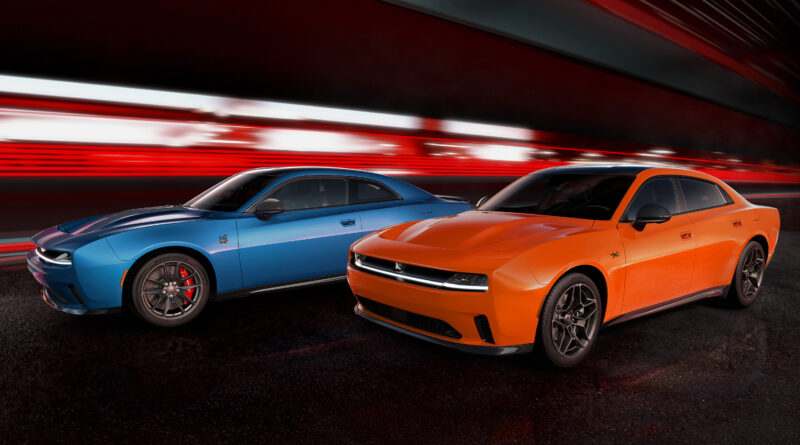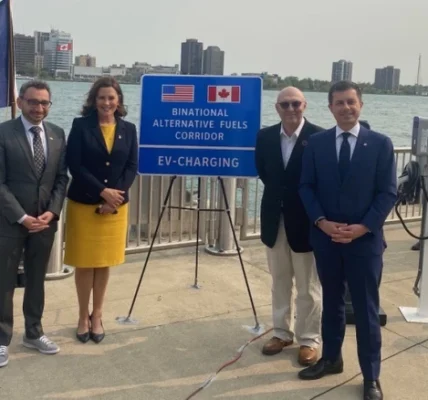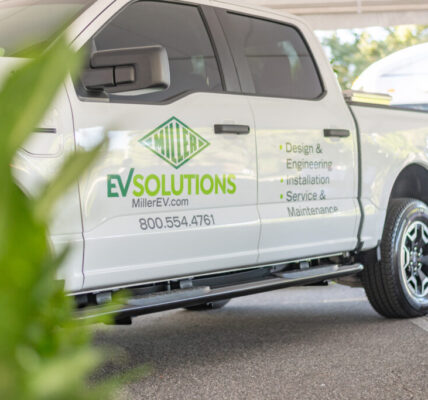We’ve seen electric vehicles run the gamut from golf carts to supercars and almost everything in between — almost, that is, until the iconic US automotive brand Dodge introduced two new all-electric versions of its classic gas-guzzling Charger muscle car. The new Dodge Charger Daytona Scat Pack and Daytona R/T are billed as the first electric vehicles to take on the challenging particulars of muscle car fandom including noise, noise, and more noise.
Dodge Wants The Noisiest Electric Vehicles In The World
We’re not sure if anyone, anywhere has rated electric vehicles based on noise emissions, but Dodge’s parent company Stellantis appears determined to climb to the top of the decibel ladder and stay there.
“Dodge Charger Daytona models feature patent-pending Fratzonic Chambered Exhaust, delivering Hellcat levels of sound intensity that set the Charger apart from ordinary BEVs,” Stellantis explains.
Teasing Hellcat-level noise out from an electric vehicle is quite an achievement, considering that electric drive is practically noise-free, and V8 engines such as those sported by the Dodge Charger Hellcat SRT are not.
Nevertheless, the crew at Dodge has invested considerable time and energy into the Fratzonic Chambered Exhaust, which is the Detroit News describes as a “a sort of electronic organ hanging under the rear of the car.” No, not that kind of organ. Our friends over at AutoBlog explain that the system shares elements with pipe organs, such as those you might find in a church.
“As a reminder, the Fratzonic exhaust is not only an external speaker system, it’s akin to a pipe organ using air through tuned chambers to produce noise. The final sound is a composite of information such as throttle position and speed. It’s loud, too, with a volume of up to 126 decibels, same as a Hellcat’s exhaust,” AutoBlog explained back in February of 2023.
Luring The Muscle Car Crowd Over To Electric Vehicles
Reportedly the system is still undergoing some further tweaks, at further time and expense. If you’re wondering why not just stop at 126 decibels, that’s a good question. Road and Track cites Dodge CEO Tim Kuniskis with the answer, which basically comes down to recognizing that sound plays a front-and-center role on the muscle car stage, electric or not.
“There’s something in it that if you’re a muscle car fan enthusiast, it subliminally makes you feel comfortable,” Kuniskis told Road and Track.
“And if you think about sound and you have all the different layers of sound — treble bass, treble midrange bass — you can tune that sound just like you tune an exhaust system, right?” he added.
Apparently Kuniskis and the rest of the Dodge team are anticipating that muscle car fans, who are on the lookout for something to make themselves stand out on the block, will at least give the new electric vehicles a test drive and check out all the bells and whistles, which Stellantis listed in loving detail in a press release on March 5 (here’s that link again).
Dodge also plans to offer ICE versions of the same cars, offering drivers the chance to compare the electric vehicle experience one-on-one. Aside from the noise factor, Dodge also zeroes in on performance.
“The Charger will retain its title as the world’s quickest and most powerful muscle car, led by the all-new, all-electric 2024 Dodge Charger Daytona Scat Pack, which delivers 670 horsepower and is expected to reach 0-60 mph in 3.3 seconds and to run the quarter-mile in an estimated 11.5 seconds,” Dodge emphasizes.
Upscaling To Attract New EV Buyers
If all goes according to plan, Dodge will start production on two-door versions of the all-electric Scat and Daytona by midyear 2024. Four-door iterations of the EVs will follow in 2025, along with new gas-powered cars. That means we’ll have to wait another couple of years to see if electric vehicles can lure muscle car fans over to the zero emission side, even when comparable gasmobiles are available.
The final pricing for the Charger EVs will be released closer to production, though for now Kelly Blue Book estimates that $52,000 is a probable starting point.
That’s a bit high compared to conventional muscle cars. Still, the bet could pay off for Stellantis. Other carmakers have also been tinkering around the edges of the market for specialty electric vehicles. Last year CleanTechnica’s Jennifer Sensiba took note of the trend, pointing out that automakers have traditionally put forth high-end products to lusterize their brands, helping to attract buyers to more affordable cars.
“The limited-production Hummer EV, the upcoming Escalade IQ, and the Cadillac Celestiq are all good examples of what just one manufacturer (GM) is doing,” she wrote. “The last one, the Celestiq, is supposed to come in at a starting price of $340,000, and that’s before any expected customizations buyers are expected to make to order.”
In a more recent example, last week the Chinese electric vehicle maker BYD introduced its own super-EV to the tune of $233,000. The company has become known for its more affordable line of zero emission vehicles, and the addition of the Ferrari-comparable U9 supercar is expected to bolster the image of its new Yangwang luxury brand.In a different kind of twist, the startup nanoFlowcell is bringing its sporty Quantino twenty-five to market in the US. The futuristic EV runs on a flow battery instead of conventional EV batteries. That sounds pricey enough, though the US cost has yet to be released.
All this activity reminds us of the earlier years of the electric vehicle market, when Rush Limbaugh and other conservative pundits trashed EV performance to anyone within range of a radio or television set.
Things began to change when FIA launched the new all-electric FIA Formula E racing series in 2015. The series has since expanded to include Extreme E, serving as a test bed for hardy off-road electric automotive technology.
If this is all beginning to ring some bells, you may be thinking of the Tesla Roadster. The electric vehicle was produced between 2008 and 2012, costing in the range of $100,000 .
CleanTechnica was among those excited by the prospects of a second iteration when rumors of a forthcoming Roadster 2 began circulating in 2018 (see more coverage here).
Apparently the assembly line will finally start cranking up later this year, or early 2025, as CleanTechnica’s Carolyn Fortuna reported earlier this week. Reservations for a limited edition $250,000 Founders Edition of the electric car are filled, but anyone with an extra $50,000 to throw around can to lay it out for a deposit on the $200,000 base model.








